In Praise of the Broken Home
Essay from The Opinonater, The New York Times

My childhood home broke in half during the autumn of 1973, when my twin sister and I were 10 years old. Our parents called us together one evening to announce that they were splitting up, and just like that we became “products of a broken home.” The scene still flickers in my mind: my sister and I sat between our two parents on a monstrous neo-Victorian couch upholstered in a weird, synthetic shade of pink. Everybody cried.
Our father ended up keeping the row house where we lived, but a few years later our mother bought the place next door. This kid-friendly arrangement softened the bite of the breakup, allowing my sister and me to jump over the porch rail whenever we felt like switching parents.
Back then, people routinely called families of divorce “broken homes,” yet a new phrase was already coming into play that cast a warmer light on the process of divorce and remarriage: “blended family.” As my own parents regrouped and remarried, they never used this kinder, gentler nomenclature, yet sociologists and psychologists were applying it in the ’60s and ’70s. Today it is common currency. Whereas “broken home” describes the destruction of an original family unit, “blended family” refers to the new marriages that sometimes follow. “Blended family” is about making, not breaking, and it implies a seamless melding of diverse ingredients. (Press “liquefy” on your Osterizer.)
In 19th-century parlance, a “broken home” was a family ruined by the death or abandonment of a parent. Members of the temperance movement applied the phrase to households besieged by alcoholism. Throughout the 20th century, sociological studies of broken homes addressed the effects of divorce on child development and teenage delinquency. A sense of moral decrepitude thus hovers around the concept, clouding it with shades of weakness, failure and doom.

I’ve been thinking about broken homes and blended families lately as I observe friends from my own generation move through various combinations of separation, divorce and re-partnering. When couples break up, they often fight about who will control the children and the house. When it’s time to remarry, they fight about which furniture gets to stay. These newly minted couples may want to merge souls and checking accounts, but “blending” seems hard to come by. Not only is it tough to reconcile two households’ worth of clashing bedspreads and warring sofas, but some kids hesitate to fully embrace their pseudo-siblings and quasi-parents.
Yet aren’t all families “broken” in some way? Marriage customs bring together two people from different lineages and place them under a common roof. By definition, marriage is a joining of unlike elements. (Close blood relatives aren’t supposed to mate. Yuck.) Even when the bond is strong, a seam both connects and divides husband, wife and the web of in-laws they bring to the table. A couple’s biological offspring really are a blend, but the rest of the family is patched together.

“Stepfamily” is a no-frills term for the reconfigured domestic units that increasingly represent the norm in the United States. Neither judgmental nor misty-eyed, “stepfamily” avoids both moral condemnation and wishful thinking. The National Stepfamily Resource Center, run by Auburn University, in Alabama, provides information for families in which one or both partners bring children from a previous relationship. “Stepfamilies do not ‘blend,’” explains the center’s Web site. “Children actively balk at inferences that the stepfamily is … eligible to demand their full attention and loyalty. They know they have divided loyalties.” Many kids find themselves entangled in multiple stepfamilies, compelling them to build bonds, however tentative, with new siblings and parents on both sides of their nuclear family tree. These children live in two houses, not one.
Parenthood has many modes: birth parent, adoptive parent, custodial parent, foster parent, grandparent, guardian, in-law and more. Technically, stepparents are “legal strangers.” Unless they officially adopt the children (which usually requires both birth parents’ consent), stepparents have no legal rights or responsibilities with regard to their partners’ offspring. Depending on local family law, they can’t sign field trip permission slips or make medical decisions for their stepchildren. Nor are they obligated to financially support their former stepchildren following a divorce.
Fairy tales seethe with such ambiguous family ties. Cinderella and Snow White fall on hard luck when their birth fathers pass away, leaving them in the care of some mean and scary “legal strangers.” Hansel and Gretel’s stepmother resents her husband’s biological children and banishes them to the big black forest to fend for themselves. While some of these legendary conflicts are about who’s the prettiest, others are about economic scarcity. Cinderella is reduced to rags while her sisters get all the party clothes; Hansel and Gretel’s stepmom doesn’t have enough food to go around.

Although most real stepfamilies do better than that, competitive rifts are common. Disturbances float to the surface as children grow up and inheritances get parceled out. Do the older kids from Dad’s first marriage deserve to get more, less or the same as the younger kids from his second marriage? The answers aren’t obvious. (For advice on how to work out such difficulties, see Paul Sullivan’s recent piece in The Times, “Blended Families Face a Thicket of Financial and Emotional Issues.”)
Children are resilient. For my sister and me, the painful news delivered that night in 1973 eventually coalesced with everyday reality. The terrible became normal, and the kids were all right. The pink couch still occupies a dark, poorly decorated corner of my mind, but its toxic glow has dimmed. I myself have been peacefully married for 20 years, and I enjoy warm relationships with my parents, stepparents and stepsiblings. My extended family is a creaky, leaky contraption whose inner workings often trip and jam around ex-marital fault lines. This home has been broken, but don’t try to fix it. The cracks and gashes have made it what it is.